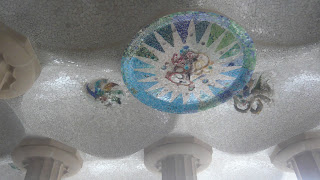Sunday, 11 August 2013
Jujol and Subirachs
Josep Maria Jujol developed his unusual architectural style through many years of close, creative collaboration with Antoni Gaudí. He helped create the doors for Casa Batlló as well as the ceramic facade, the ceilings and columns of Casa Milà, as well as the wrought iron banisters, and was responsible for the colourful ceramics decorating the serpentine seats and ceilings of Park Güell. Jujol was famous for utilizing waste materials such as broken tiles, plates, bottles, cups, glasses, and jugs when creating mosaics.
Jujol’s work 'is characterized by a high degree of sensibility to the forms of nature, an emphatically anti-geometric aesthetic, attention to workmanship and detail, as well as the imaginative use of old and previously utilized material. It is an eloquent expression of his affection for the Catalonian landscape, his modesty, and deep religious faith.'
Jujol's work was not restricted to collaborations with
Gaudí and an interesting piece Richard Eilers in the Guardian describes visits to some sites associated with Jujol. The monument at the Plaça d'Espanya (see photograph above) is also by Jujol, although not one of his lighter and better works.
Josep Maria Subirachs is the Catalan sculptor who, in 1986, was commissioned to create the groups of sculptures on the Passion Façade of the Sagrada Família. 'Subirachs dedicated almost twenty years (1987 to 2005) to this group of works, which can be considered the synthesis and culmination of his career as a sculptor, comprising more than one hundred figures sculpted in stone and four bronze doors. To represent the last two days in the life of Jesus Christ, he revisited his figurative expressionism stage in search of the dramatic effect the theme required.'
'The expressionist aspect of Subirachs' works is more formal than conceptual and can be found, above all, in the typically distorted angular bodies and in the treatment of textures, when he incorporates grattage, refraining from leaving surfaces smooth, making them rough, jagged, coarse, in order to accentuate the expressive capacity of the material.' His work on public sculptures has been considered a milestone in the artistic renovation of Spain in the 20th century.
'A multi-faceted artist, Subirachs has not only expressed himself through tridimensional creation, but also by means of other techniques such as painting, drawing, graphic art (etching, drypoint, serigraphy and lithography), tapestry, book illustration, medal minting and designing jewellery and other utilities.' Much work by Subirachs can be found in Barcelona, including the monument to the president of the Catalan Government, Francesc Macià, at the Plaça de Catalunya (see photograph above).
-------------------------------------------------------------------------------------------------
Adrian Snell - Gethsemene.
Labels:
architecture,
barcelona,
catalonia,
collage,
expressionism,
gaudi,
jujol,
monuments,
public art,
sculpture,
subirachs,
trencadis
Subscribe to:
Post Comments (Atom)








2 comments:
Thank you for sharing this.
I went to Barcelona for three days last year. It was one of the best experiences I have ever had upon entering the Sagrada Familia!!!
People were in tears as they walked around as the effect was so amazing.
I look forward to going back again.
One thing I particularly liked about the Sagrada Familia was that all the Biblical imagery was on the walls outside before you entered the building. Once you had come in, there was essentially no explicitly Christian imagery to be seen, instead through the form of the columns and the colour of the windows you had the sensation of being in a forest with your eye constantly drawn upwards to the source of light. I felt that made the space profoundly contemplative despite the huge throng of people there doing all that tourists normally do.
Post a Comment